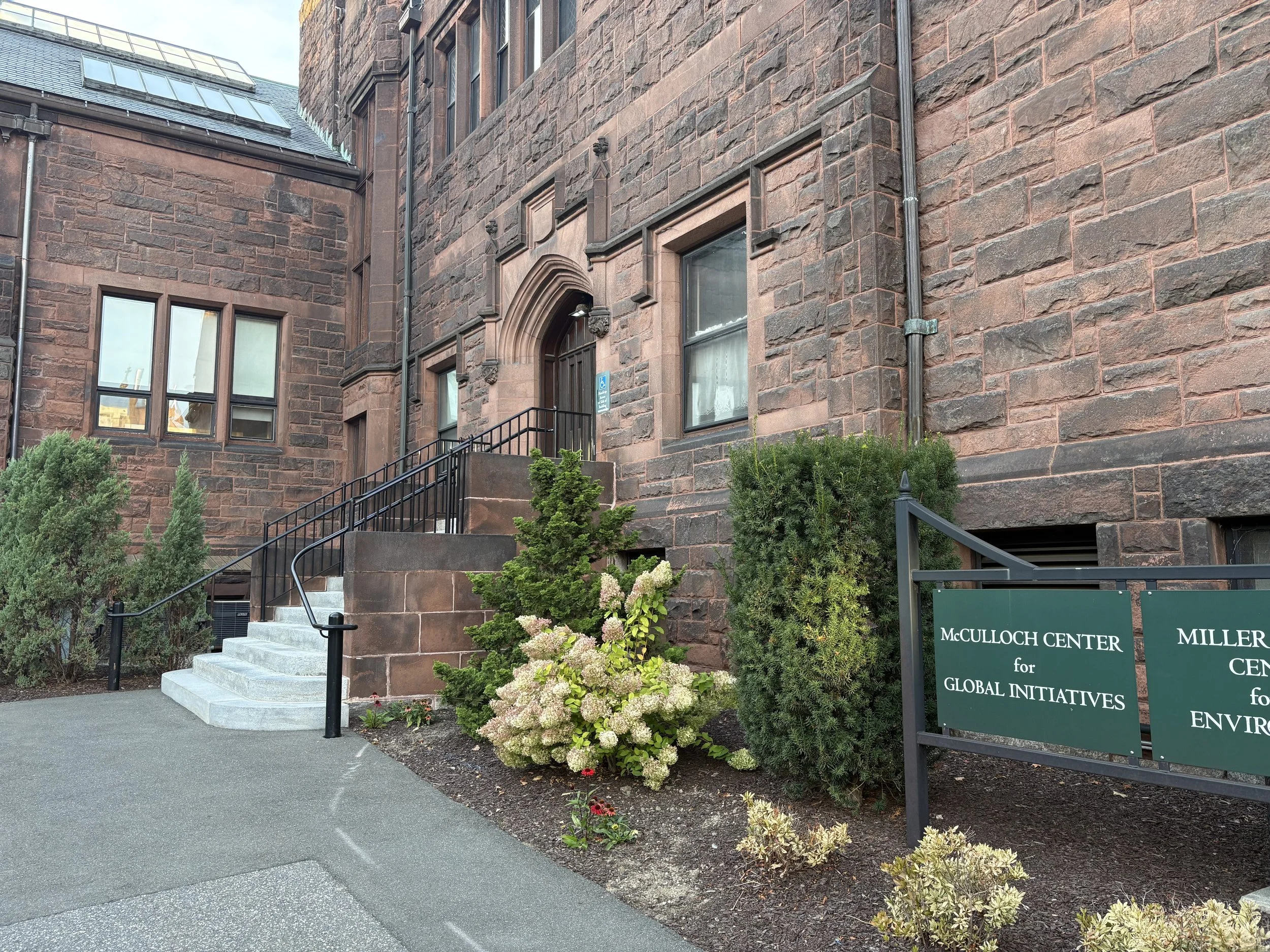Photo by Kiera McLaughlin ’26
The McCulloch Center for Global Initiatives’ office can be found on the first floor of Dwight Hall.
By Kiera McLaughlin ’25
Global Editor
Last semester, on April 14, students, faculty and staff filled the Great Room for a closed forum hosted by Mount Holyoke College’s administration about federal attacks on academic freedom and immigration. At the time, international students around the country were being targeted for their social media posts and participation in protests supporting Palestine, as previously reported by Mount Holyoke News.
When school ended, the discussion came to an end for most. Domestic students, like myself, still did not truly understand the visa process, let alone the threat international students face when the government terminates their papers.
Starting this past summer, international students have been forced to share social media when interviewed during their visa application to ensure they do not “pose a threat to U.S. national security,” according to a post by the State Department.
Then on Sept. 19, President Donald Trump issued a proclamation requiring a $100,000 annual fee for employers of H-1B visa applications, a temporary, nonimmigrant work visa for international workers in technology sectors, The Guardian reported. According to Duke University’s Career Hub, H-1B visas are commonly used by international students after graduating.
In order to better understand the issues that have resulted from these policies, both past and present, here’s a brief 101 on student visas and what has changed since the beginning of the second Trump administration.
The majority of the international students at MHC have an F-1 visa, a nonimmigrant visa for students studying at an accredited U.S. college or English-language school, according to the U.S. Department of State. There are also several J-1 visa holders, for international students participating in an exchange program.
Jennifer Medina, assistant director of the McCulloch Center of Global Initiatives and senior immigration advisor, explained the visa application process for Mount Holyoke students to MHN in an interview.
After being accepted into Mount Holyoke College, international students reach out to Medina to request required documents and share their passport, proof of funding, and family contribution information. Once everything is in order, Medina sends an I-20 form to them, which is required for the F-1 visa.
As soon as the student receives an I-20 form, the visa application officially begins. With everything available online through the Department of State website, the student fills out forms and pays fees to schedule an interview, according to Medina.
This interview process lasts around five minutes, and consists of the student explaining their personal situation and sharing relevant documentation. According to Medina, interviewers analyze interviewees’ English skills and how long they intend to stay in the U.S., since both the F-1 and J-1 visas are specifically nonimmigrant visas.
“For an undergrad student, they're really looking at your immediate family. Do you have many aunts and uncles that are already in the U.S? Does that lead the visa officer to think, ‘Hmm, the student may end up staying there on a permanent basis,’ and that's not something the non-immigrant visa is for, regardless of what you're going to do in the future,” explained Medina.
As of now, they also require that your social media be publicly accessible. Medina explained that in the past the interview took a day to process, but with the social media vetting process it can now take up to 10 days.
“They are going to vet your social media to make sure there’s nothing antisemitic, there’s nothing anti-American, there’s nothing anti-Trump … they’re going through it much more carefully,” Medina said.
Sometimes when entering the country, international students are required to once again hand over their phone for screening. Medina said this has caused lots of questions about whether the confiscator will think they are hiding something for people that do not have social media.
Despite this simple-sounding process, the visa application requires students to successfully jump through hurdles in and out of their control, including potential problems with documentation, communication, timeliness and the interview process before they can come to South Hadley.
This year, Medina explained there was a two week pause period in June by the U.S. Department of State which made it hard for students to apply on time or process their application.
“We did have some students not be able to get here for the fall semester just because they couldn’t get a visa … so we do have students coming in the spring, more students than we normally would,” Medina said.
If the federal government were to terminate a student visa at Mount Holyoke College, the international student would likely receive a message to the email they originally applied with, and the information would be recorded on their Student and Exchange Visitor Information System — or SEVIS — record, which contains an international student’s enrollment status and visa information for both F-1 and J-1 applicants. There is also the possibility that a student’s SEVIS record may be directly terminated. The McCulloch Center of Global Initiatives has access to each student’s SEVIS and can monitor the status.
“We’re always here for help and questions that students have just because we know that everything is so uncertain and there’s so much out there in the media. There’s so many things that are happening to friends at other schools,” Medina said.
When it comes to the role of domestic students, Medina recommends students “just be there to listen and then point students in the right direction.”
For previous reporting about the situation last spring, http://www.mountholyokenews.com/news/2025/4/15/what-to-know-trumps-immigration-actions-and-mount-holyoke
For more information and immigration resources, https://offices.mtholyoke.edu/global/international_students/visa_immi
Quill Nishi-Leonard ’27 contributed fact checking.

